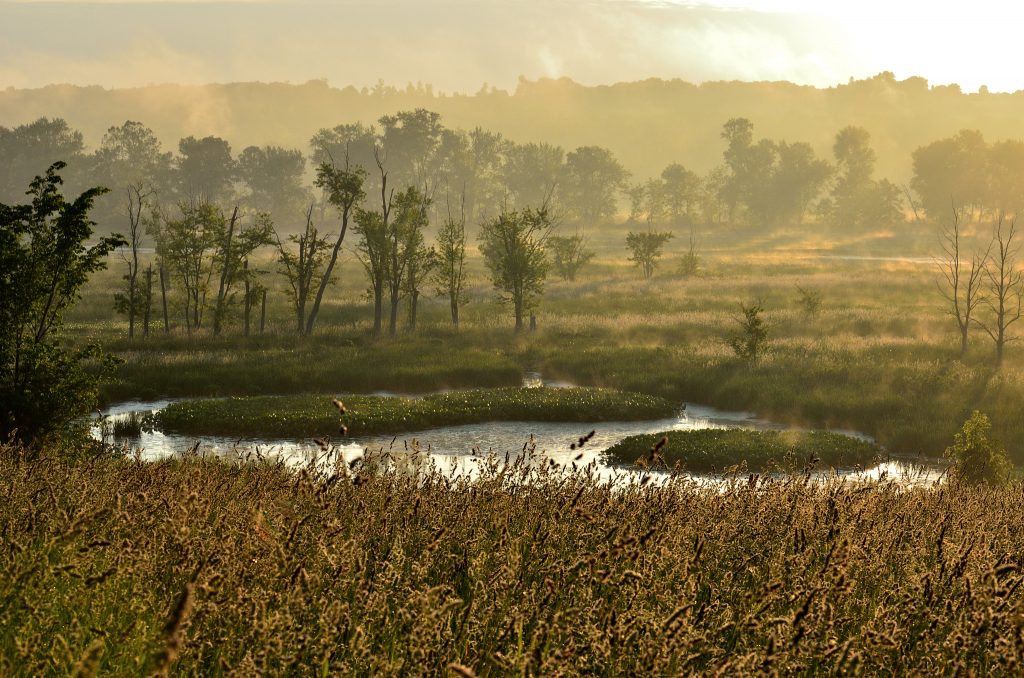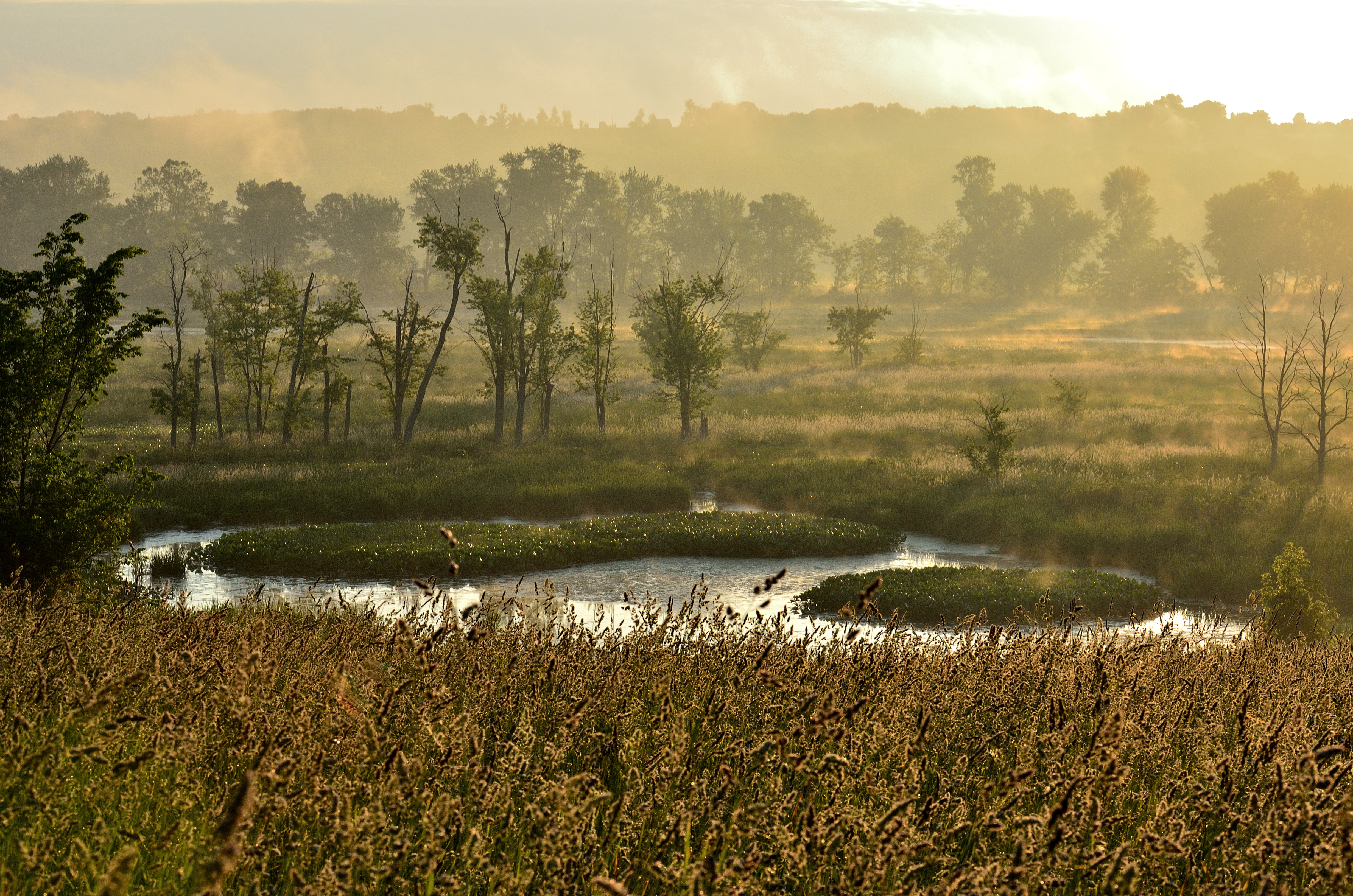One day this summer I got up well before dawn, to load gear into the car and drive down to a favorite location in the Killbuck Marsh area, some twenty miles south. I parked the car just off the side of the dirt road, strapped gear onto my back, and headed into a field of tall weeds and wild grass, chest high and very wet from the overnight fog and dew. Before I’d gone thirty yards, I was thoroughly soaked from the chest down, with water running into my boots. It was difficult pressing through the thick growth in the near darkness, and I was panting with exertion.
In the middle of the field, I was suddenly almost knocked over backward by a large bird that leapt up directly in front of me, nearly hitting me in the face, and flew off. After the initial startlement (and a few colorful words) I regained my composure and looked down. There was the nest, on the ground at my feet, with nine eggs, slightly smaller than chicken eggs. I took photos, first without flash in the dim pre-dawn light, using the lens’s widest aperture and a slow shutter, trying to hold as still possible (not easy with my heart still pounding), and then with the on-camera flash, hedging my bets. Then I carefully skirted the nest and continued on. In the dim light, and being so startled, I hadn’t gotten a good look at the bird I had so rudely disturbed, but later research confirmed that it was a wild turkey. (In fact, a little later in the summer I would see several of the young turkeys scampering around in the same field.)
In the darkness, with pack and gear on my back, pressing through the tall, heavy, wet growth, along very uneven and hilly terrain, it took nearly half an hour to cover only about half a mile out to the spot I had previously scouted and chosen to shoot from: an elevated ridge overlooking the western side of the creek and marsh, which I knew would be heavily shrouded in mist. My plan was to capture the light of the rising sun through that mist.
Using my Photographer’s Ephemeris, I had checked the sunrise time beforehand, but my turkey encounter and the effort of my slow slog through the weeds put me a little behind schedule, so I arrived just as the sun was breaking over the horizon, showing only as a brightening spot through the fog above the marsh. I had decided to use the 18-105mm lens, giving me a choice from wide angle to short telephoto, and I’d put it on the camera before leaving the car, so I lined up a few sighting shots, moving around to try different perspectives. I knew the light I wanted wouldn’t last very long, so I needed to get some shots pretty quickly.
For landscape shots, I often use f/22, to give me good depth-of-field, but since the light was still pretty dim, I compromised at f/16. I left the ISO set at automatic, so the camera could choose between 100 and 1600 (the min and max I typically allow it to work with), adjusting as needed for changing light. When I had a shot zoomed and framed up the way I wanted, I checked the scale on the lens and saw it was around 60mm. With that focal length, I knew from experience that I could hand-hold that lens (which has Nikon’s VR image stabilization) with shutter speeds down to at least 1/60″, and get good results, but I twisted the shutter speed up to 1/160″ and saw that the camera had bumped the ISO up to only 500, which is perfectly acceptable, so I started shooting. I varied shutter speed, kept the aperture at f/16, moved about to try different perspectives, and varied the focal length to frame the scene in different ways. As I shot, I periodically checked the histogram, to make sure it was staying within acceptable limits, not butting up too hard against either right or left edge.

Rising early, and with a little effort, I was rewarded with the kind of beautiful, ethereal morning light I had envisioned.
As the sun came up and the mist disappeared, carrying with it that marvelous, ethereal morning light, I looked down the slope past a stand of trees, thinking about heading down that way to see what birds might be around, when suddenly my attention was captured by movement along the edge of the woods. I raised the camera and zoomed the lens to its full 105mm reach, and saw that a young buck had just emerged from the treeline and was moving toward me. He was still a fair distance from where I stood, but my motion caught his attention, and he raised his head and looked directly at me. I got in a couple of quick shots with that lens, and slowly—oh, slowly—eased straight down into the tall grass, out of his view. Crouching low and hidden, I very quickly changed to my preferred walk-around wildlife lens, an old 75-300mm push-pull style zoom, with autofocus but unfortunately no image stabilization. (When you’re out in the field for an extended shooting spree, it’s often good to have a couple of lenses to choose from, so you can switch from shooting landscapes to birds, or whatever. I typically have two lenses in the bag, in addition to the one on the camera at any given time.)
With a longer lens, more suited to shooting skittish animals from a distance, I very slowly—slowly!—eased back up from my crouch, with the camera already set and held up to my eye, so I would have to move as little as possible once I had the deer in my sight. I was hoping—oh, hoping!—that he’d have gone back to his meandering business, and that I might be able to creep carefully and cautiously closer, and maybe, just maybe, bag a young buck. But the deer was still suspicious, and still staring in my direction. I got off one quite lousy shot at him, still at long range, before he let me know what he thought of me by showing his hind end and bounding rapidly in the other direction.

Through a longer lens the buck is more clearly visible, but still staring suspiciously in my direction.
The morning was a success though, as I got some nice shots of the sunrise through the mist, over the marsh, which had been my primary purpose in going out that morning. And my encounter with the deer was not a total waste, even though I didn’t get a decent shot that day. After he retired from the field that morning, I did some further exploration in the vicinity, and saw plenty of tracks and sign that let me know he, and others, made their home in that little section of woods and field, next to the creek and marsh. So I began to go there specifically for deer, and eventually I got some lovely shots. It’s now one of my favorite places to go, to enjoy the beauty and peace of nature, and to see what kind of subjects I can find for my camera. Getting up before dawn can be challenging, but it is often worth the effort.




